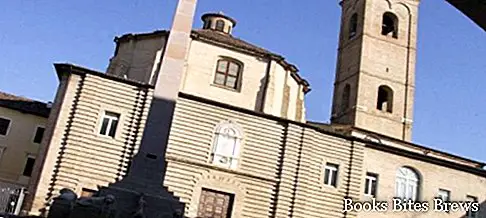What to see in Jesi, itinerary including main monuments and places of interest, including Cathedral of San Settimio, Palazzo Pianetti, Civic Museum, Pinacoteca Lorenzo Lotto and Teatro Pergolesi.
Tourist information
Located in the Marche in the province of Ancona, from which it is 31 km away, in the lower Esino valley, Jesi has very ancient origins, it was a Roman colony in 247 BC. with the name of Aesis and it became a free municipality in the eleventh century, before becoming a cause of contention for a few centuries between the Malatesta, the Sforza and Braccio da Montone.
Federico II of Svevia was born in Jesi in 1194, and Giovan Battista Pergolesi in 1710 was also one of the first cities to set up a print shop.
The visit can be started from the Cathedral of San Settimio which, erected between the thirteenth and fifteenth centuries, has a facade and an interior with a Latin cross remodeled.
Palazzo Balleani is an interesting example of local Baroque, enriched by a balcony.
The Convent of San Floriano, dating back to the eighteenth century, shows a particular dome flanked by the vast Church abundantly decorated inside.
Inside the fourteenth-century walls, built on the layout of the Roman walls and of which the six gates and towers remain, there is the medieval core of the city.
The Church of San Marco, located a short distance from the historic center and dating back to the thirteenth century, is characterized by an interior with three naves where an interesting fourteenth-century fresco of the Milanese school is kept.
The Palazzo della Signoria, dating back to the end of the fifteenth century, has some interesting elements, including the tower, the portal and the porticoed courtyard, inside which the museum and the art gallery are set up.
What see
In the Civic Museum you can see some remains of ancient Aesis, including statues, fragments of pottery from architectural insertions and funerary epigraphs, as well as Della Robbia pottery, pharmacy vases and ceramics.
In the Pinacoteca, some paintings by Lorenzo Lotto are of particular interest, including Visitation, Annunciation, Madonna and Child with Saints, St. Francis receiving the Stigmata, St. Gabriel and St. Lucia in front of Pascascio, the latter's masterpiece from 1531.
Recommended readings- Fossombrone (Marche): what to see
- Marche: Sunday day trips
- Fermo (Marche): what to see
- Marche: what to see among valleys, hills and ancient villages
- Osimo (Marche): what to see
The sixteenth-century Palazzo Ricci is characterized by a remarkable rusticated facade.
The Pergolesi Theater was inaugurated in 1798 with two representations of works by Cimarosa.
Palazzo Pianetti, built around 1750, is an excellent example of the Italian rococo style.
The building has a very long facade, on which a hundred windows open, while on the back there is a spectacular Italian garden.
The Church of Santa Maria delle Grazie, built in the fourteenth century, but with a bell tower from the seventeenth century, preserves inside a fresco attributed to Antonio da Fabriano, depicting the Madonna of Mercy.
The thirteenth-century Church of San Nicolò has a Romanesque apse and a Gothic portal.




